#especially of like 2014 to 2017
Explore tagged Tumblr posts
Text
Jayvik's ethereal forms and just viktor form when he's in the arcane was MADE for tumblr artist I mean this it's so elentori art coded ifykyk
#reminds me of 2014-2017 art you know like dare I say (voltron) like I'm not crazy#viktor arcane#art#arcane#jayce x viktor#jayce arcane#jayce talis#viktor league of legends#doomed yaoi#their so fucking pretty#especially viktor like HHHHHHUUUUNNGGGGG#He makes me so angry that he's so beautiful#gay
20 notes
·
View notes
Text
reblog and put in tags the prominent musical artists phases in your life
#im just intrigued what music would consume you beyond repairrrrrr#if you're not acting a little crazy while consuming music are you really doing it right????#bon's queen gifset of sand made me think of this so bon if u see thissss#prior to 2013 i was a bollywood girlieeee and bollywood is almost entirely playback singing which an entire different thinggggh#2013 - enrique iglesias#2014 - maroon 5#2015 - coldplay#2016 - sam smith#2017 - ed sheeran & calvin harris#2018 - Queen & george ezra#2019 - p!atd (i KNOW) & khalid#2020 - harry styles & idkhbtfm & troye sivan#2021 - billie eilish & conan gray & hozier#2022 to present - taylor swift#vi.txt#the embarrassment i feel when i remember some of the absolute unhinged stuff i have done in some of then phases AAAAAAAA#i have never truly been a normal fangirl smh especially as a fucking teenager#in class 9 my friends and i LEGITIMATELY CUT A BIRTHDAY CAKE for shahid kapoor IN THE CLASSROOM during recess infront of all#he wasn't even really that popular at the time WHICH IS EVEN MORE STUPID GOD THE THINGS I HAVE DONE#and like i wasn't even that big of a fan but my closest best friend at the time was into him hence so was i#although in hindsight it was just because i had started exhibiting gay feelings subconsciously but wE wErE jUsT tHe bEsTeSt oF fRiEnDs ufff#im not wiser of course i can be tempted to be that unhinged again#the reblog game is just an excuse for shitposting this in the tags tbh#idk why i am even making this post tho#only friends has rotted my brain tbh#ALSO in 2015-2017 the internet stand up comedy scene was booming in india and that phase was truly even more embarrassing for me#it was the reason i joined instagram and the CRINGE i feel when i sort my likes and comments from oldest to newest GOODNESSS#truly an insufferable fan rip my mom and my friends#such a core teenage girlhood (genderneutral) experience methinks#if this flops.....you never saw it heheh
22 notes
·
View notes
Text
"Research on a police diversion program implemented in 2014 shows a striking 91% reduction in in-school arrests over less than 10 years.
Across the United States, arrest rates for young people under age 18 have been declining for decades. However, the proportion of youth arrests associated with school incidents has increased.
According to the U.S. Department of Education, K–12 schools referred nearly 230,000 students to law enforcement during the school year that began in 2017. These referrals and the 54,321 reported school-based arrests that same year were mostly for minor misbehavior like marijuana possession, as opposed to more serious offenses like bringing a gun to school.
School-based arrests are one part of the school-to-prison pipeline, through which students—especially Black and Latine students and those with disabilities—are pushed out of their schools and into the legal system.
Getting caught up in the legal system has been linked to negative health, social, and academic outcomes, as well as increased risk for future arrest.
Given these negative consequences, public agencies in states like Connecticut, New York, and Pennsylvania have looked for ways to arrest fewer young people in schools. Philadelphia, in particular, has pioneered a successful effort to divert youth from the legal system.
Philadelphia Police School Diversion Program
In Philadelphia, police department leaders recognized that the city’s school district was its largest source of referrals for youth arrests. To address this issue, then–Deputy Police Commissioner Kevin Bethel developed and implemented a school-based, pre-arrest diversion initiative in partnership with the school district and the city’s department of human services. The program is called the Philadelphia Police School Diversion Program, and it officially launched in May 2014.
Mayor-elect Cherelle Parker named Bethel as her new police commissioner on Nov. 22, 2023.
Since the diversion program began, when police are called to schools in the city for offenses like marijuana possession or disorderly conduct, they cannot arrest the student involved if that student has no pending court case or history of adjudication. In juvenile court, an adjudication is similar to a conviction in criminal court.
Instead of being arrested, the diverted student remains in school, and school personnel decide how to respond to their behavior. For example, they might speak with the student, schedule a meeting with a parent, or suspend the student.
A social worker from the city also contacts the student’s family to arrange a home visit, where they assess youth and family needs. Then, the social worker makes referrals to no-cost community-based services. The student and their family choose whether to attend.
Our team—the Juvenile Justice Research and Reform Lab at Drexel University—evaluated the effectiveness of the diversion program as independent researchers not affiliated with the police department or school district. We published four research articles describing various ways the diversion program affected students, schools, and costs to the city.
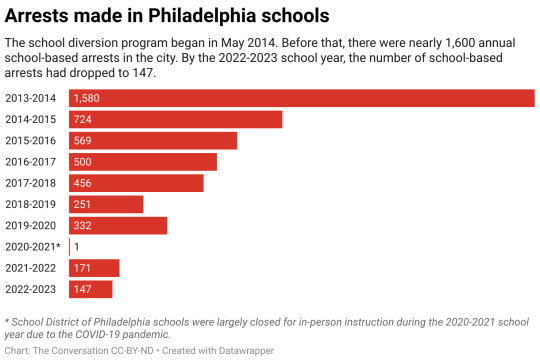
Arrests Dropped
In our evaluation of the diversion program’s first five years, we reported that the annual number of school-based arrests in Philadelphia decreased by 84%: from nearly 1,600 in the school year beginning in 2013 to just 251 arrests in the school year beginning in 2018.
Since then, school district data indicates the annual number of school-based arrests in Philadelphia has continued to decline—dropping to just 147 arrests in the school year that began in 2022. That’s a 91% reduction from the year before the program started.
We also investigated the number of serious behavioral incidents recorded in the school district in the program’s first five years. Those fell as well, suggesting that the diversion program effectively reduced school-based arrests without compromising school safety.
Additionally, data showed that city social workers successfully contacted the families of 74% of students diverted through the program during its first five years. Nearly 90% of these families accepted at least one referral to community-based programming, which includes services like academic support, job skill development, and behavioral health counseling...
Long-Term Outcomes
To evaluate a longer follow-up period, we compared the 427 students diverted in the program’s first year to the group of 531 students arrested before the program began. Results showed arrested students were significantly more likely to be arrested again in the following five years...
Finally, a cost-benefit analysis revealed that the program saves taxpayers millions of dollars.
Based on its success in Philadelphia, several other cities and counties across Pennsylvania have begun replicating the Police School Diversion Program. These efforts could further contribute to a nationwide movement to safely keep kids in their communities and out of the legal system."
-via Yes! Magazine, December 5, 2023
#philedelphia#pennsylvania#united states#us politics#school#high school#school to prison pipeline#prison system#arrests#education#students#schools#good news#hope#rare case of police not completely sucking#police#policing#law enforcement
1K notes
·
View notes
Text
Q: Which of the Hyungs gives you the best conform and the most attention
Jungkook: Jimin hyung. (2014)
Q: How were you able to overcome the harsh trainee life?
Jungkook: Jimin hyung comforted me and listened to my worries. (2013/ 2014)
Q: Who is the easiest hyung to talk to?
Jungkook: Jimin hyung. (2015)
Q: BTS relationship chart.
Jungkook about Jimin:
“All nighter friend”. All the time it’s just the two of us doing something at night. I don’t know what we do. (2016)
Q:Who do your feel your heart is most connected to?
Jungkook: Jimin hyung…….there’s something we just get about each other both on and off stage. (2019)
Q:Who knows you best? (2018)
Jungkook: Jimin hyung
Q:What comes to your mind when you think about the members (2021)
RM: Leader
Jin: 30
Yoongi: grandfather
Jhope: dance
Jimin: charming/ attractive
V: friend.
Q:Describe each members charm in one word (2021)
RM: Dull/ absent minded
Jin: Interested
Yoongi: Interested
Jhope: Positive
Jimin: considerate/ thoughtful
V: Lonely
Q: What are the members to Jungkook? (2020)
RM: Leader
Jin: oldest big brother who feels like a friend.
Yoongi: My oldie
Jhope: My bro
Jimin: my “You are me- I am you”
V: my commonality.
(Jungkook fetches and gives a pair of sleepers to a manager standing barefoot) (2022)
Members especially Hobi….”wow Jk that is so thoughtful. That is amazing
Jungkook: “I always do what Jimin hyung does”.
Jungkook about Jimin: (2015/2016)
TO JIMIN: He has an extremely reliable existence. He gives me strength, provides me motivation and hyung tells me I do the same for him. We are similar in our mutual love for the stage. Our relationship is of mutual synergy. I am grateful to him for having passion and for continuing to hold onto his dreams.
Jungkook to Jimin: (2015/2016/ 2017)
He is my catalyst
Jungkook describing Jimin: (2015/2016)
“Ah Jimin hyung…he has a very kind personality. He also treats me to lots of good food. His eyes when he smiles are so pretty. There is no one else on the team who is as charming as he is.
If I were a girl, I would want someone with that personality…let’s go with Jimin hyung. If I were a girl, I would date Jimin hyung.”
Jungkook about trips he took with Jimin ( 2023)
“These are the best trips I have ever had in my life”.
“ I want to go back to the first day of our trip”
“Let’s do this till we are 50”
There is nothing clearer!
223 notes
·
View notes
Text
I ended up recording bits of songs and mixing them and now I've accidentally finished like 2 of them but shoutout to the winning result which I already did a few days ago unfortunately
#the spreadsheet is pure autism#many many findings been found#measured the amount of bangers vs filler in all my playlists for all the months between jan 2014 to dec 2023#and the conclusion was: 2017 and 2015 had the most music#2019 and 2014 had the least#however 2014 didn't have a lot of filler whereas 2015 did#but the final finding was that 2017 had the most bangers being listened to per week. and 2019 had the least#and it could've been considered a waste of time bc i technically already knew that bc i'm already on the spectrum about yhat sort of thing#but twas fun so it doesn't matter 👍 i love spreadsheets and analysis and listening to music and remembering everything and combining these#but yeah today and yesterday has just been doing hunros jorna stuff. and it's usually pain bc it involves trying to get a good sound#especially for vocals and guitar. which is hard bc i can barely sing and i literally don't play guitar#but i've managed to get some sexy tones??? and i never know how that happens#on guitar i mean. vocals are forever eguhhhhgheughehhhhhhh#but like i'll have the worst guitar tone in the history of recorded sound and then i'll change like one thing with the eq or something#and then suddenly it's this rich vibey ethereal juicy colourful shiny sound and it's like. how did that happen#but i never know how i did it and i won't be able to recreate it on another song#it's a secret only a guitarist would be able to know and i'm incapable to understanding instruments with more than 4 strings#anyway hi#ramble
2 notes
·
View notes
Note
I don’t really have a lot to ask I just want to say I love your art style! It kind of reminds me of like Eldritch Horror meets Celestial Divinity type of thing so with that said I was wondering on how you came to this type of art style you do and how long did it take you to experiment until you found the style that you wanted? Sorry if that sounds kinda confusing 😅 thanks for taking the time to read this and have a good rest of your day!
Thank you! I did not found my artstyle, my artstyle found me. Here is a timeline of my digital art/illustration journey
2014 - The beginning
I finally took my tablet and bit the bullet that was digital art. I remember specifically forcing myself to draw (because it was not fun) because I wanted to learn digital art no matter what it took.

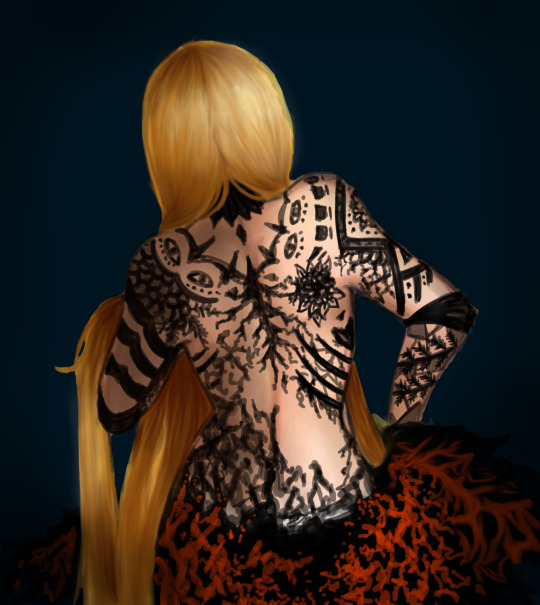
2016 - Experimental
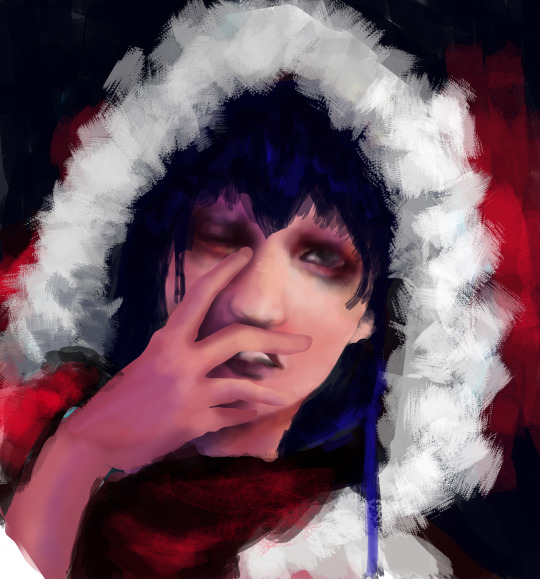

Boldness seems to have dominated this phase, not because of the themes but because I rendered without any under sketch (example above of how the first draft looked like vs the end)
2017 - The breakthrough

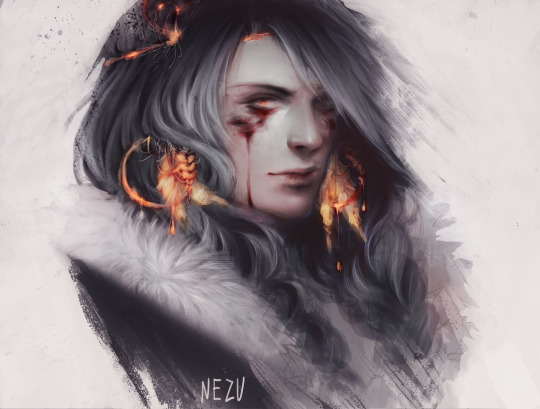
It was only from here that digital art began feeling RIGHT. The most important things I've learned were how to render texture variation (especially softer things like hair and fur) and how to color a drawing from greyscale. I was slowly settling onto my desired artstyle
2019 - Happy accident
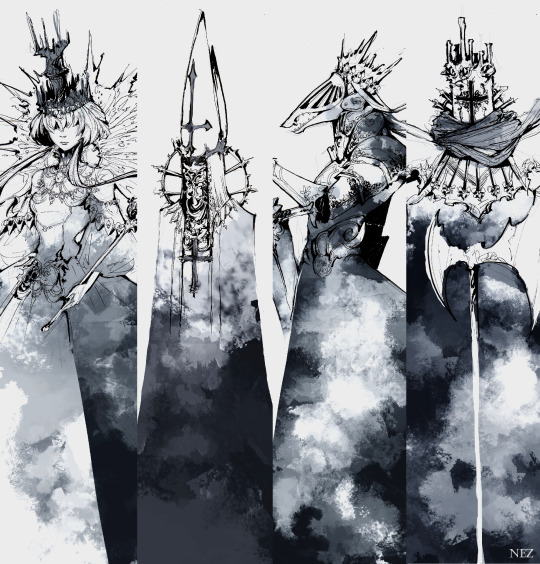
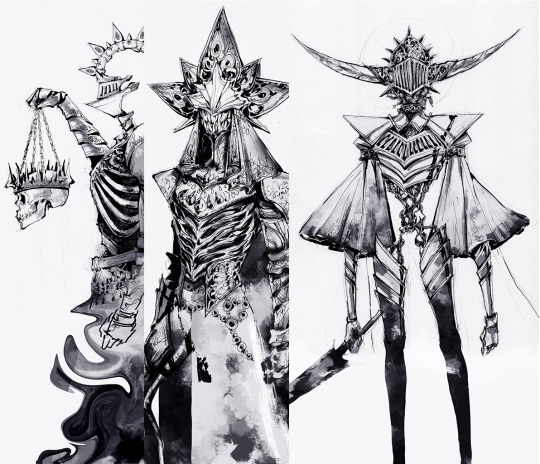
We were tasked to design characters based on chess pieces during college. 1 week deadline. With the mindset that no one will see my designs except my teacher and I, I did things boldly and rendered them (trad ink plus digital shading) to emphasize shape and design, rather than texture variation.
I began mixing traditional lineart with digital rendering.
2020 - Fallen from heaven
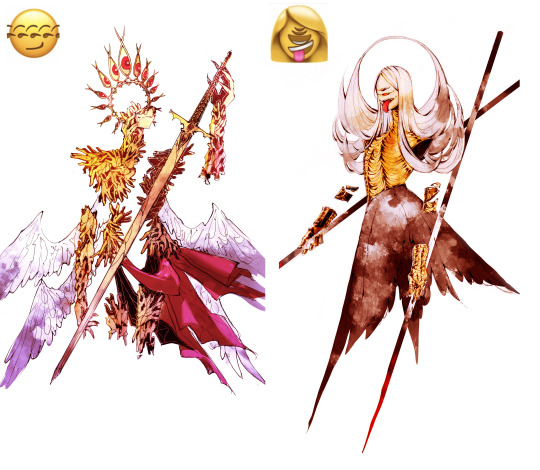

My friend and I decided to attempt to design angels based on widely popular tumblr emoji mashups. It was the first time I colored one of my character design drawings, using similar methods to the ones I've learned in 2017.
2017 - 2024

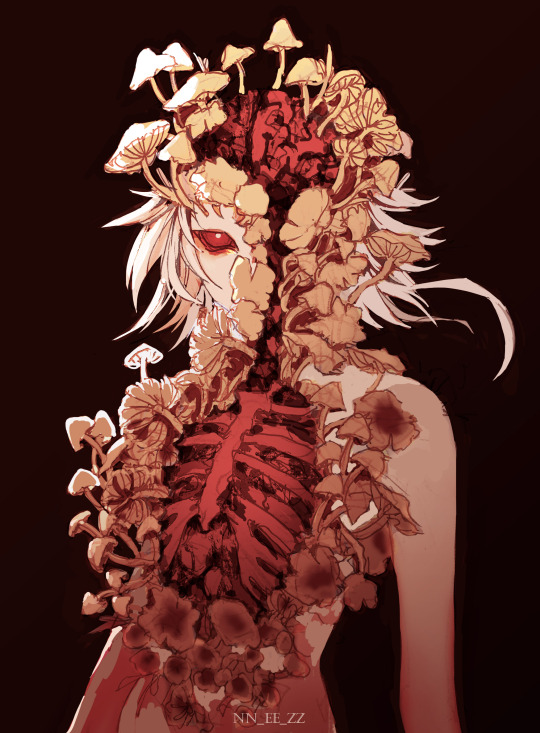
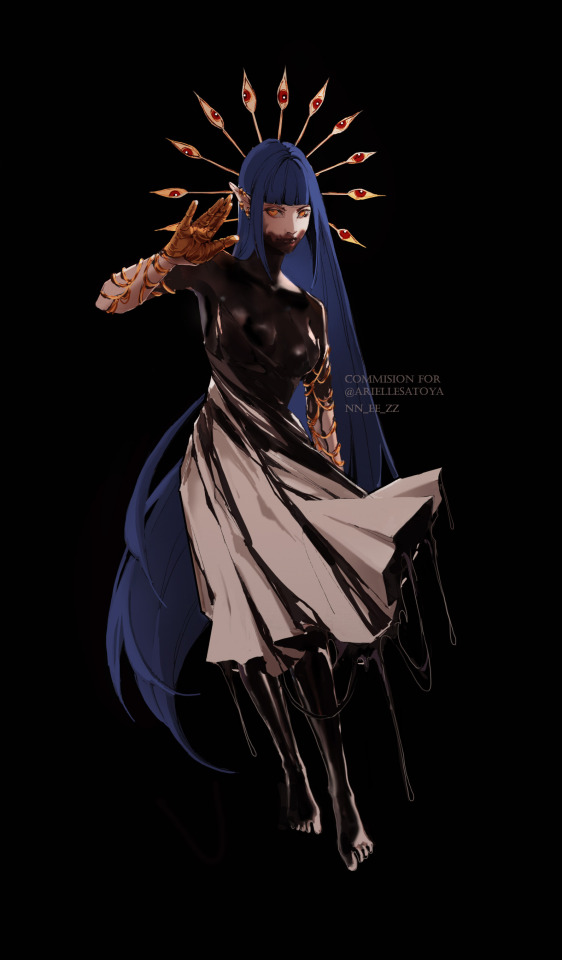
I cannot name nor describe my artstyle nowadays. I haven't seen many people with something similar either. I use what I've learned in all my phases; the spontaneous boldness of 2016, the texture variation of 2017, the sharp shapes and design mindset of 2019, the mix of traditional and digital from 2020. It all melted together and keeps evolving.
The way I approached art changed too. I was so worried about making things beautiful and technically outstanding when today I only worry about making things interesting and readable.
585 notes
·
View notes
Text
A BioWare Guide on How to Murder a Fanbase
I have been a Dragon Age super-fan for almost fourteen years, now. I have played every game, with every DLC. I have read every novel, lore book, and every comic — yes, even the terrible ones that are better off forgotten. I have seen the anime film, the animated series, and the web mini-series. I have enjoyed all of these pieces of the franchise over and over, more times than I can count. So, make no mistake: the negativity you’re about to hear comes from a place of love for this fantasy world, developed by many creative people over the years. I would love nothing more than to see the resurrection of passion in the Dragon Age fandom again. But the unfortunate truth is, that resurrection is only needed because BioWare took the fandom out back and shot it in the first place.
In December 2018, three years after the release of Dragon Age: Inquisition’s Trespasser epilogue DLC, BioWare first announced the then-untitled next Dragon Age game with a teaser trailer. At this point, most fans were anticipating this would mean within the next couple years, we would see the game. This assumption was based on the fact that Dragon Age: Inquisition was first announced in 2012, and released in 2014, with an extra year of development added last minute.
There have been dribbles of extra content since then, adding to the franchise. This was enough to keep some fans still breathing and interested. 2020’s Dragon Age: Tevinter Nights was a lovely anthology. 2020’s Dragon Age: Blue Wraith and 2021’s Dark Fortress were wonderful comics tying up the story started in Knight Errant. And 2022’s Dragon Age: Absolution was a well-animated series with an interesting cast of characters and story. But all these still left the fandom with a major question: What was going on with the next game? It was untypical of BioWare to be so secretive, in comparison to how they handled sharing information of the past games in the franchise. The only form of updates fans still have to go on is mostly just concept art and short stories, hinting that something must be in production. But why was the wait so long?
In 2015, the first version of the next Dragon Age began with a clear vision, clear scope of practice, and a reportedly happy developer team. Most gloriously in my book, there was no multi-player… but this did not align with the Electronic Arts typical money-mad schemes. EA’s push for “games as a service” meant they wanted to monetize all their games as much as possible, and therefore, they wanted them to be a live service — as Anthem demonstrated, that meant sacrificing things that are staples of good RPGs, like narrative and character choice. So in 2017, version one of the next Dragon Age was scrapped and replaced. This new version would have, in total or to at least some degree, an online portion of play.
There is one part of Schreier’s article, “The Past and Present of Dragon Age 4,” that really sticks out to me, regarding this:
“One person close to the game told me this week that Morrison’s critical path, or main story, would be designed for single-player and that goal of the multiplayer elements would be to keep people engaged so that they would actually stick with post-launch content.”
The idea of splitting up components of a game into single-player and multi-player is a terrible idea, because it means that there would be a large bulk of content only accessible through online gaming; something many fans, like myself, are repulsed by. Even if I did enjoy it, I spent most of my life growing up with either no internet or shoddy internet incapable of playing online games. I know many rural people who are still in that position, losing more and more of their favourite gaming pastimes because they are locked out of the ability to play them. It is a disservice to hide content behind a wall like this, especially in a world that is so lore-heavy like Dragon Age. The news of multi-player in Dragon Age understandably upset many, and this is when I first noticed a large drop off in excitement over the next game.
However, in 2021, the failure of Anthem (multi-player) and success of Star Wars Jedi: Fallen Order (single-player) led the executives at EA to bend to the wishes of BioWare leadership and allow them to go back to the drawing board yet again on the next Dragon Age. This meant removing all multi-player content!
While I am very happy that there will reportedly be no multi-player in Dragon Age: Dreadwolf, I can’t help but feel bitter and a little disgusted over the ridiculous development time spent on something no one but EA wanted in the first place. If it weren’t for this foolishness, Dragon Age: Dreadwolf would be in our hands right now. Instead, it’s been in development hell for nearly nine years and counting. Nine years is a long time to expect fans to carry a torch for you through radio silence, but it’s no wonder BioWare has shared barely anything about the next game; it’s been in flux for so long, they likely haven’t had anything concrete to show.
BioWare hurt its reputation even more when the news broke that the studio very suddenly laid off 50 people who were working on Dragon Age: Dreadwolf. This is pretty damning on its own, but BioWare took it a step further. Former developer Jon Renish shared a statement revealing that the studio was only willing to offer laid-off employees two weeks of severance per year of service, and denied health benefits. The denial of health benefits in particular is a pretty wild move for a studio with a reputation for “stress casualties”. The latest news on this is that BioWare has still so far refused to negotiate better severance packages, leading to a lawsuit. The lawsuit originally had 15 former employees, but this dropped due to the fear of not being able to afford to pay their bills. So now, while EA sits on $400 million net income, the laid-off employees are struggling to buy holiday presents for their children. These horrid business practices are not to be ignored when accounting for a lack of faith in a studio. What kind of monsters reward workers who make your games special with vaguely reasoned lay-offs?
The latest news on the Dragon Age: Dreadwolf front from BioWare came early this month, December 2023, with a trailer… announcing a trailer that will come next summer… that will announce the release of the game. Supposedly. Maybe. We’ll see. But by this time, BioWare is something of a laughing stock of their own fandom. Reactions to the video released with a pretty map graphic and a few rendered locations were, from what I personally observed, mostly sardonic in nature. People have commented on the vapourware nature of the game, and like all vapourware, that leads to disintegrating trust.
Despite all this, people like Mary Kirby, (one of the veteran Dragon Age writers who was a victim of the layoffs,) said, “it’s bittersweet that Dreadwolf is my last DA game, but I still hope you all love it as much as I do,” encouraging fans to still support the game when it eventually is released. But after every misstep BioWare has taken, that’s a tough sell now. Fans are finicky, RPG fans more so than others, one could argue. We have our favourites, and many of us stick to those favourites for life over our appreciation for the artistry — but that relationship between studio and fan should go both ways. EA and BioWare has betrayed that relationship, and it will take a hell of a lot to build it back up again, now.
[This piece is also available on Medium!]
#dragon age#datv#dragon age dreadwolf#bioware#game development#meta#releasing this into the wild and running away
658 notes
·
View notes
Text
Stray Kids with an S/O who is a huge horror movie fan
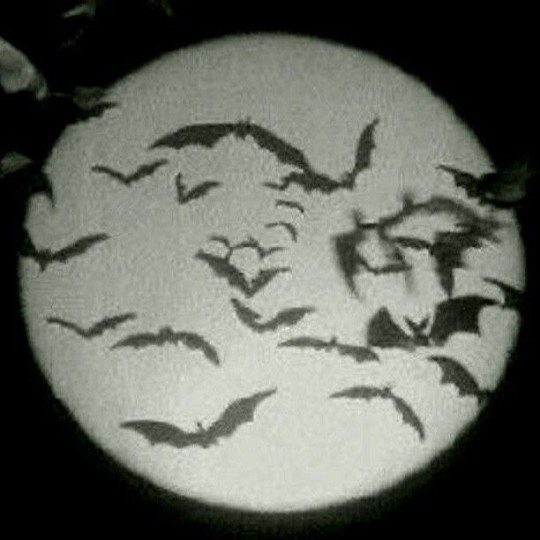
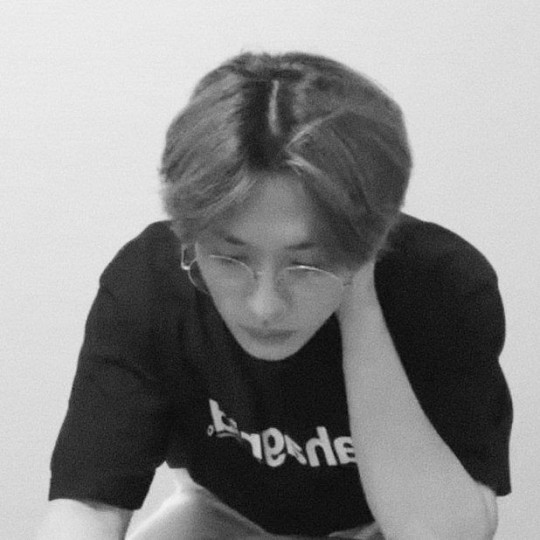
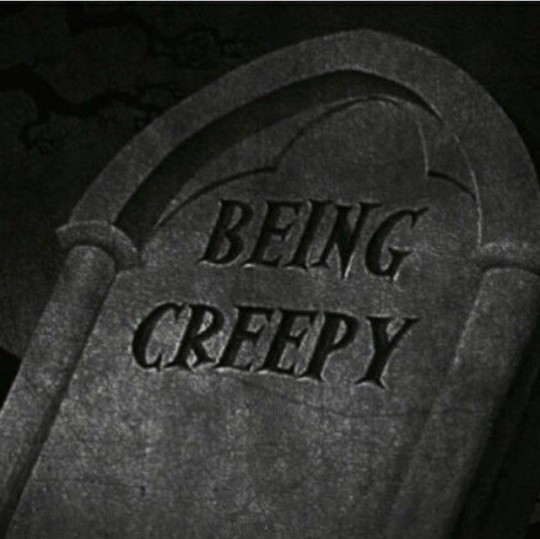
pairing: ot8 x gn!reader
genre: fluff
disclaimer: this is as always just my opinion :)
a/n: as a huge horror movie fan myself, I had to write this! enjoy!🩷
Chan:
As he said before, it's not like he's scared of horror movies, he just doesn't think they're interesting to watch. But, you're interesting to him and he loves you so he will definitely try for you. He also thinks he won't get scared cause 'nothing scares him' but oh boy was he wrong. You have to promise him extra cuddles because he's not gonna be able to fall asleep that night. Will also try to dissect the plot with you after the movie, and try to find meaning in the story just so it's less scary to him.
If he was never really invested into the horror genre, you could show him the classics like The Shining(1980), The Omen(1976), The Amityville Horror (1979), Psycho(1960) and then also some newer iconic movies like Get Out(2017), The Ring(2002), Sinister(2012), Hereditary(2018) and The Conjuring(2013).
Minho:
Loves it. Loves to try and scare you while you're watching a movie together. At first, you're so happy that you can share your love for horror with your significant other. And you know he really doesn't like jumpscares, so you try to find movies that don't have many of those. But if they do and Minho predicts a jumpscare, he'll grab you at the same time it's happening, making you jump out of your skin even though you saw the movie already. You kinda start regretting watching horror movies with him because he annoys you on purpose. He thinks you're so adorable when you're mad at him, but he wont push too far and he'll always make it up with cuddles and kisses later. Overall, 10/10 experience.
I feel like he'd watch almost any horror movie cause he's a curious cat (hehe) and you'd both share your favorites.
I don't know why, but I also feel like Minho would appreciate good old silent horror movies. I just think if he's a horror fan he may enjoy seeing the roots of horror. Like The Cabinet Of Dr. Caligari(1920), Dr. Jekyll and Mr. Hyde(1920), The Phantom Carriage(1921), Nosferatu(1922) and Häxan(1922).
Changbin:
I don't think he's too scared of them but I think he doesn't really care for them too much? Though, if you have some interesting thriller or detective movies to recommend he will definitely wanna watch them with you. I think Changbin likes a movie that has an intelligent story with a plot twist. He likes to guess what's gonna happen next and when he's actually right he'll be so happy and proud. He'll keep talking about how he guessed the plot and how smart he is and how you have to give him extra cuddles now. Either way, you're cuddling and snacking the whole time while watching and it's just nice and cozy.
I think he'd enjoy thrillers like The Game(1997), Fracture(2007), The Machinist(2004), The Double(2013), Shutter Island(2010), Zodiac(2007) and 1408(2007).
Hyunjin:
Miss him with that shit cause he ain't watching it unless you manage to coax him into it. It's gonna take a lot of persuading until he finally gives in but you have to be careful in choosing the right movie for Hyunjin. He doesn't like loud noises and he doesn't really like to feel scared. He'd rather watch something for the story, especially if it's an emotional one, and he also likes character driven stories.
I think he could watch artsy or slow creepy movies that are more drama-like but have elements of horror like Pan's Labyrinth(2006), Dark Water(2005), Windchill(2007), It Follows(2014), The Eyes Of My Mother(2016), I'm Thinking Of Ending Things(2020) and Case 39(2009).
Jisung:
Okay, with this one you can go crazy. Any weird horror movie, anything kinda disturbing, deranged or unhinged will be right up his ally. As a horror and anime fan himself, he's seen some pretty weird stuff so experiment, I guess. I also feel like he'd like fun horror movies, idk how to explain but ones that are disturbing but fun at the same time, like you can't look away even though you're looking at a train wreck.
Movies like Funny Games(2007), The Ruins(2008), Suspiria(1977), The Perfection(2018), Perfect Blue(1997), May(2002), Audition(2000), Saw franchise and Terrifier series would be fun for him. Also, since he mentioned Paranormal Activity, found footage horror movies would be fun to watch with Jisung too like Creep(2014), REC(2007), Unfriended(2015) and Cloverfield(2008).
Felix:
This is just not happening unless you can bribe him with cookies, gummies or any other sweets and ofcourse many cuddles and kisses, even more than you share usually. You'll have to practically beg him to watch a horror movie with you or make some kind of compromise that you'll participate in some activity he likes more than you later. He's not gonna sleep all night if you make him watch anything too scary, actually he wouldn't even be watching that. He'd probably be hidden in your neck the whole time and even the creepy sounds coming from the tv will give him nightmares.
The only way to make him watch horror movies is if they're mixed with comedy or they're so bad that they're funny. Like the Scream franchise, The Cabin In The Woods(2011), What We Do In The Shadows(2014), The Happening(2008), Tucker & Dale vs. Evil(2010), Housebound(2014) and ofcourse zombie comedies like One Cut Of The Dead(2017) and Shaun Of The Dead(2004).
Seungmin:
Kind of indifferent towards the scares but I think he gets annoyed with plot holes and characters acting stupid. Rolls his eyes at every over used trope or cliche sentence. You actually end up laughing while watching horror movies with him because he's too cute when he's annoyed.
"How is this killer still alive? He's been run over by a truck ten times, this is stupid!" or "Okay but why is he going towards the sound? Is he that dumb, he's gonna die!"
He does like dry humor though so he'd like some black comedy movies with horror elements like American Psycho(2000), Parasite(2019), The Lobster(2015), The Menu(2022) but also if you want to annoy him on purpose (because he's cute when he gets worked up) show him slashers like the Halloween franchise, Friday the 13th franchise and Black Christmas(2019).
Jeongin:
With Jeongin, I feel like it can go either way and it definitely depends on the theme of the movie. Also, he will probably try to act brave in front of you (until he jumps at a loud sound and then gets embarassed). For some reason I don't have an exact subgenre of horror for him but for some reason I feel like he'd like newer horror movies like Us(2019), Nope(2022), Last Night In Soho(2021), His House(2020), Host(2020), The Invisible Man(2020) and Fear Street film series.
#skz x reader#skz fluff#stray kids#bang chan x reader#hyunjin x reader#stray kids x reader#lee felix x reader#changbin x reader#han jisung#lee know x reader#han x reader#seungmin x reader#jeongin x reader#skz scenarios#skz headcanons#bang chan#lee know#seo changbin#hyunjin#lee felix#seungmin#jeongin
344 notes
·
View notes
Note
what do you recommend for people who are very new to deadpool comics and looking to get into them?
hiii thank u for asking!! this is kind of a complicated question because there's no right answer really. especially with deadpool, there's no actual best starting point because besides the basic origin story that he was experimented on, everything else about him is fair game (he just lies all the time and has false memories about his past) and so all the comics are different and some are pretty much standalones. but here's a list of a few comics depending on what you want to explore (i have not read every deadpool comic ever so this is not the best list but i will get there):
for shorter and more lighthearted reads:
deadpool (2022)—SO so cute wade has a crush on this non-binary assassin and it's actually adorable how much he likes them lol. in terms of shorter deadpool comics i think this one is quite a standout [update: the ongoing deadpool (2024) is brilliant as well and is a direct more in-depth continuation of this]
deadpool infinity comic (2021)—a short partnership with sue storm. funny and the art style is so cute too
deadpool (2018) #6—the issues in this run are all kinda standalone stories (although they all connect at the end). they're all a fun time but this issue in particular is hilarious. comics usually don't make me actually laugh but this one did
for a more meta read that explores exactly what makes wade unique from other superheroes:
deadpool kills the marvel universe (2011)—in my opinion THE most iconic deadpool run, i'm sure everyone's heard of it lmao. a little darker but hey cameos from every marvel character ever. this was the first deadpool comic i ever read and it was a good time
for a familiar face from deadpool and wolverine (for other specific familiar faces you could just search "deadpool vs [character]" and that comic would probably exist):
honestly just search "deadpool and wolverine" and you'll probably get the whole list but here are some i've read that are lovely:
deadpool & wolverine: wwiii (2024)
deadpool vs. wolverine: slash 'em up infinity comic (2024)
weapon x-traction (2024)
for long in-depth characterisation that explores a lot of deadpool lore:
deadpool (2012)—if you've been following me you might know this is my favourite deadpool comic ever. it's pretty depressing and much grittier than the movie deadpool you might be used to, also REALLY long so it can be daunting but it's very worth it imo. it starts to get really good by the good, the bad, and the ugly issue and there's just SO much in it. for me wade in this run is inseparable from wade as a character to me (this comic is also followed up with deadpool (2015) and despicable deadpool (2017). these aren't necessary to read because 2012 kind of wraps up on its own, but it's definitely bittersweet to get to the end)
deadpool (1997)—another hulk of a comic run. i have not read this yet but i've heard very good things about it, and many people say that joe kelly is the defining deadpool writer so you could give it a go! older comics may be a little harder to read though, from experience
for comics featuring ellie (wade's daughter) that you may want to read in order if you want to fully appreciate her and wade's relationship:
deadpool (2012, 2014, 2015)
deadpool (2018, issues #8, #12, #15)
deadpool (2024)
a lot of comics will sometimes redirect you to other comics that explore a sideplot, and the main comic will just pick up where those left off so you could miss some storyline. despite this it's not necessary to read those other comics, but if you want to avoid multiple instances of this when you first go in, then i would suggest starting with the shorter runs!!
i hope this was helpful lmao sorry this got really long but i think the starting point really is different for everyone depending on what they like
#user: gossippool 😝#gossippool asks#i'll probably keep updating this as i go along#deadpool and wolverine#deadpool#wade wilson
191 notes
·
View notes
Text
The Real Cost of the Fashion Industry
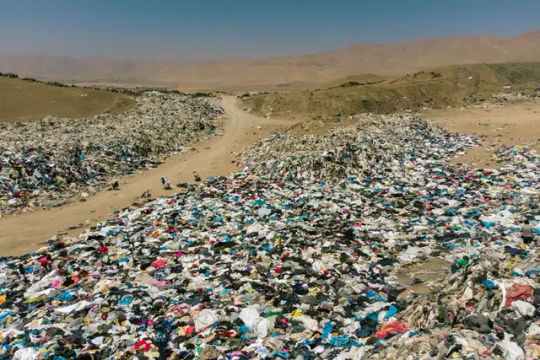
Atacama Desert, in Alto Hospicio, Iquique, Chile. (source)
The textile industry is destroying the world. The industry is wasting massive amounts of energy and materials, and polluting the air, the ground and the water supplies. It overwhelmingly exploits it's labour and extracts wealth from colonized countries, especially in Asia. I assume we all broadly understand this, but I think it's useful to have it all laid out in front of you to see the big picture, the core issues causing this destruction and find ways how to effectively move forward.
The concerning trend behind this ever-increasing devastation are shortening of trend cycles, lowering clothing prices and massive amount of wasted products. Still in year 2000 it was common for fashion brands to have two collections per year, while now e.g. Zara produces 24 collections and H&M produces 12-16 collections per year. Clothing prices have fallen (at leas in EU) 30% from 1996 to 2018 when adjusted to inflation, which has contributed to the 40% increase in clothing consumption per person between 1996 and 2012 (in EU). (source) As the revenue made by the clothing industry keep rising - from 2017 to 2021 they doubled (source) - falling prices can only be achieved with increasing worker exploitation and decreasing quality. I think the 36% degrees times clothing are used in average during the last 15 years (source) is a clear indication on the continuing drop in quality of clothing. Clothing production doubled between 2000 and 2015, while 30% of the clothes produced per year are never sold and are often burned instead (source), presumably to prevent the returns from falling due to oversupply.
These all factors are driving people to overconsume. While people in EU keep buying more clothes, they haven't used up to 50% of the clothes in their wardrobe for over a year (source). This overconsumption is only made much worse by the new type of hyper fast fashion companies like SHEIN and Temu, which are using addictive psychological tactics developed by social media companies (source 1, source 2). They are cranking up all those concerning trends I mentioned above.
Under the cut I will go through the statistics of the most significant effects of the industry on environment and people. I will warn you it will be bleak. This is not just a fast fashion problem, basically the whole industry is engaging in destructive practices leading to this damage. Clothing is one of those things that would be actually relatively easy to make without massive environmental and human cost, so while that makes the current state of the industry even more heinous, it also means there's hope and it's possible to fix things. In the end, I will be giving some suggestions for actions we could be doing right now to unfuck this mess.
Carbon emissions
The textile industry is responsible for roughly 10% of the global CO2 emissions, more than aviation and shipping industry combined. This is due to the massive supply chains and energy intensive production methods of fabrics. Most of it can be contributed to the fashion sector since around 60% of all the textile production is clothing. Polyester, a synthetic fiber made from oil which accounts for more than half of the fibers used in the textile industry, produces double the amount of carbon emissions than cotton, accounting for very large proportions of all the emissions by the industry. (source 1, source 2)
Worker exploitation
Majority of the textiles are produced in Asia. Some of the worst working conditions are in Bangladesh, one of the most important garment producers, and Pakistan. Here's an excerpt from EU Parliament's briefing document from 2014 after the catastrophic Rana Plaza disaster:
The customers of garment producers are most often global brands looking for low prices and tight production timeframes. They also make changes to product design, product volume, and production timeframes, and place last-minute orders without accepting increased costs or adjustments to delivery dates. The stresses of such policies usually fall on factory workers.
The wage exploitation is bleak. According to the 2015 documentary The True Cost less than 2% of all garment factory workers earned a living wage (source). Hourly wages are so low and the daily quotas so high, garment workers are often forced through conditions or threats and demand to work extra hours, which regularly leads to 10-12 hour work days (source) and at worst 16 hour workdays (source), often without days off. Sometimes factories won't compensate for extra hours, breaching regulations (source).
Long working hours, repetitive work, lack of breaks and high pressure leads to increased risks of injuries and accidents. Small and even major injuries are extremely common in the industry. A study in three factories in India found that 70% of the workers suffered from musculosceletal symptoms (source). Another qualitative study of female garment workers and factory doctors in Dhaka found that long hours led to eye strain, headaches, fatigue and weight loss in addition to muscular and back pains. According to the doctors interviewed, weight loss was common because the workers work such long hours without breaks, they didn't have enough time to eat properly. (source) Another study in 8 factories in India found that minor injuries were extremely common and caused by unergonomic work stations, poor organization in the work place and lack of safety gear, guidelines and training (source). Safety precautions too are often overlooked to cut corners, which periodically leads to factory accidents, like in 2023 lack of fire exists and fire extinguishers, and goods stacked beyond capacity led to a factory fire in Pakistan which injured dozens of workers (source) or like in 2022 dangerous factory site led to one dead worker and 9 injured workers (source).
Rana Plaza collapse in 2013 is the worst industrial accident in recent history. The factory building did not have proper permits and the factory owner blatantly ignored signs of danger (other businesses abandoned the building a day before the collapse), which led to deaths of 1 134 workers and injuries to 2 500 workers. The factory had or were at the time working for orders of at least Prada, Versace, Primark, Walmart, Zara, H&M, C&A, Mango, Benetton, the Children's Place, El Corte Inglés, Joe Fresh, Carrefour, Auchan, KiK, Loblaw, Bonmarche and Matalan. None of the brands were held legally accountable for the unsafe working conditions which they profited off of. Only 9 of the brands attended a meeting to agree on compensation for the victim's families. Walmart, Carrefour, Auchan, Mango and KiK refused to sight the agreement, it was only signed by Primark, Loblaw, Bonmarche and El Corte Ingles. The compension these companies provided was laughable though. Primemark demanded DNA evidence that they are relatives of one of the victims from these struggling families who had lost their often sole breadwinner for a meager sum of 200 USD (which doesn't even count for two months of living wage in Bangladesh (source)). This obviously proved to be extremely difficult for most families even though US government agreed to donate DNA kits. This is often said to be a turning point in working conditions in the industry, at least in Bangladesh, but while there's more oversight now, as we have seen, there's clearly still massive issues. (source 1, source 2)
One last major concern of working conditions in the industry I will mention is the Xinjiang raw cotton production, which is likely produced mainly with forced labour from Uighur concentration camps, aka slave labour of a suspected genocide. 90% of China's raw cotton production comes from Xinjiang (source). China is the second largest cotton producer in the world, after India, accounting 20% of the yearly global cotton production (source).
Pollution
Synthetic dyes, which synthetic fibers require, are the main cause of water pollution caused by the textile industry, which is estimated to account for 20% of global clean water pollution (source). This water pollution by the textile industry is suspected of causing a lot of health issues like digestive issues in the short term, and allergies, dermatitis, skin inflammation, tumors and human mutations in the long term. Toxins also effect fish and aquatic bacteria. Azo dyes, one of the major pollutants, can cause detrimental effects to aquatic ecosystems by decreasing photosynthetic activity of algae. Synthetic dyes and heavy metals also cause large amounts of soil pollution. Large amounts of heavy metals in soil, which occurs around factories that don't take proper environmental procautions, can cause anaemia, kidney failure, and cortical edoem in humans. That also causes changes in soil texture, decrease in soil microbial diversity and plant health, and changes in genetic structure of organisms growing in the soil. Textile factory waste water has been used for irrigation in Turkey, where other sources of water have been lacking, causing significant damage to the soil. (source)
Rayon produced through viscose process causes significant carbon disulphide and hydrogen sulphide pollution to the environment. CS2 causes cardiovascular, psychiatric, neuropsychological, endocrinal and reproductive disorders. Abortion rates among workers and their partners exposed to CS2 are reported to be significantly higher than in control groups. Many times higher amounts of sick days are reported for workers in spinning rooms of viscose fiber factories. China and India are largest producers of CS2 pollution, accounting respectively 65.74% and 11,11% of the global pollution, since they are also the major viscose producers. Emission of CS2 has increased significantly in India from 26.8 Gg in 2001 to 78.32 Gg in 2020. (source)
Waste
The textile industry is estimated to produce around 92 million tons of textile waste per year. As said before around 30% of the production is never sold and with shortening lifespans used the amount of used clothing that goes to waster is only increasing. This waste is large burned or thrown into landfills in poor countries. (source) H&M was accused in 2017 by investigative journalists of burning up to 12 tonnes of clothes per year themselves, including usable clothing, which they denied claiming they donated clothing they couldn't sell to charity instead (source). Most of the clothing donated to charity though is burned or dumbed to landfills (source).
Most of the waste clothing from rich countries like European countries, US, Australia and Canada are shipped to Chile (source) or African countries, mostly Ghana, but also Burkina Faso and Côte d'Ivoire (source). There's major second-hand fashion industries in these places, but most of the charity clothing is dumbed to landfills, because they are in such bad condition or the quality is too poor. Burning and filling landfills with synthetic fabrics with synthetic dyes causes major air, water and soil pollution. The second-hand clothing industry also suppresses any local clothing production as donated clothing is inherently more competitive than anything else, making these places economically reliant on dumbed clothing, which is destroying their environment and health, and prevents them from creating a more sustainable economy that would befit them more locally. This is not an accident, but required part of the clothing industry. Overproduction let's these companies tap on every new trend quickly, while not letting clothing the prices in rich countries drop so low it would hurt their profits. Production is cheaper than missing a trend.
Micro- and nanoplastics
There is massive amounts of micro- and nanoplastics in all of our environment. It's in our food, drinking water, even sea salt (source). Washing synthetic textiles accounts for roughly 35% of all microplastics released to the environment. It's estimated that it has caused 14 million tonnes of microplastics to accumulate into the bottom of the ocean. (source)
Microplastics build up into the intestines of animals (including humans), and have shown to probably cause cause DNA damage and altered organism behavior in aquatic fauna. Microplastics also contain a lot of the usual pollutants from textile industry like synthetic dyes and heavy metals, which absorb in higher quantities to tissues of animals through microplastics in the intestines. Studies have shown that the adverse effect are higher the longer the microplastics stay in the organism. The effects cause major risks to aquatic biodiversity. (source) The health effects of microplastics to humans are not well known, but studies have shown that they could have adverse effects on digestive, respiratory, endocrine, reproductive and immune systems. (source)
Microplastics degrade in the environment even further to nanoplastics. Nanoplastic being even smaller are found to enter blood circulation, get inside cells and cross the blood-brain barrier. In fishes they have been found to cause neurological damage. Nanoplastics are also in the air, and humans frequently breath them in. Study in office buildings found higher concentration of nanoplastics in indoor air than outdoor air. Inside the nanoplastics are likely caused mostly by synthetic household textiles, and outdoors mostly by car tires. (source) An association between nanoplastics and mitochondrial damage in human respiratory cells was found in a recent study. (source)
Micro and nano plastics are also extremely hard to remove from the environment, making it even more important that we reduce the amount of microplastics we produce as fast as possible.
What can we do?
This is a question that deserves it's own essays and articles written about it, but I will leave you with some action points. Reading about these very bleak realities can easily lead to overwhelming apathy, but we need to channel these horrors into actions. Whatever you do, do not fall into apathy. We don't have the luxury for that, we need to act. These are industry wide problems, that simply cannot be fixed by consumerism. Do not trust any clothing companies, even those who market themselves as ethical and responsible, always assume they are lying. Most of them are, even the so called "good ones". We need legislation. We cannot allow the industry to regulate itself, they will always take the easy way out and lie to their graves. I will for sure write more in dept about what we can do, but for now here's some actions to take, both political and individual ones.
Political actions
Let's start with political actions, since they will be the much more important ones. While we are trying to dismantle capitalism and neocolonialism (the roots of these issues), here's some things that we could do right now. These will be policies that we should be doing everywhere in the world, but especially rich countries, where most of the clothing consumption is taking place. Vote, speak to others, write to your representative, write opinion pieces to your local papers, engage with democracy.
Higher requirements of transparency. Right now product transparency in clothing is laughably low. In EU only the material make up and the origin country of the final product are required to be disclosed. Everything else is up to the company. Mandatory transparency is the only way we can force any positive changes in the production. The minimum of transparency should be: origin countries of the fibers and textiles in the product itself; mandatory reports of the lifecycle emissions; mandatory reports of whole chain of production. Right now the clothing companies make their chain of production intentionally complex, so they have plausible deniability when inevitably they are caught violating environmental or worker protection laws (source). They intentionally don't want to be able to track down their production chain. Forcing them to do so anyway would make it very expensive for them to keep up this unnecessarily complex production chain. These laws are most effective when put in place in large economies like EU or US.
Restrictions on the use of synthetic fibers. Honestly I think they should be banned entirely, since the amount of microplastics in our environment is already extremely distressing and the other environmental effects of synthetic fibers are also massive, but I know there are functions for which they are not easily replaced (though I think they can be replaces in those too, but that's a subject of another post), so we should start with restrictions. I'm not sure how they should be specifically made, I'm not a law expert, but they shouldn't be used in everyday textiles, where there are very easy and obvious other options.
Banning viscose. There are much better options for viscose method that don't cause massive health issues and environmental destruction where ever it's made, like Lyocell. There is absolutely no reason why viscose should be allowed to be sold anywhere.
Governmental support for local production by local businesses. Most of the issues could be much more easily solved and monitored if most clothing were not produced by massive global conglomerations, but rather by local businesses that produce locally. All clothing are made by hand, so centralizing production doesn't even give it advantage in effectiveness (only more profits for the few). Producing locally would make it much more easier to enforce regulations and it would reduce production chains, making production more effective, leaving more profits into the hands of the workers and reducing emissions from transportation. When the production is done by local businesses, the profits would stay in the producing country and they could be taxed and utilized to help the local communities. This would be helpful to do in both exploited and exploiter countries. When done in rich countries who exploit poorer ones, it would reduce the demand for exploitation. In poor countries this is not as easily done, since poor means they don't have money to give around, but maybe this could be a good cause to put some reparations from colonizers and global corporations, which they should pay.
Preventing strategic accounting between subsidiaries and parent companies. Corporate law is obviously not my area of expertise, but I know that allowing corporations to move around the accounting of profits and losses between subsidiaries and parent companies in roughly 1980s, was a major factor in creating this modern global capitalist system, where corporations can very easily manipulate their accounting to utilize tax heavens and avoid taxes where they actually operate, which is how they are upholding this terrible system and extracting the profits from the production countries. How specifically this would be done I can't tell because again I know shit about corporate law, so experts of that field should plan the specifics. Overall this would help deal with a lot of other problems than just the fashion industry. Again for it to be effective a large economic area like EU or US should do this.
Holding companies accountable for their whole chain of production. These companies should be dragged to court and made to answer for the crimes they are profiting of off. We should put fear back into them. This is possible. Victims of child slavery are already doing this for chocolate companies. If it's already not how law works everywhere, the laws should be changed so that the companies are responsible even if they didn't know, because it's their responsibility to find out and make sure they know. They should have been held accountable for the Rana Plaza disaster. Maybe they still could be. Sue the mother fuckers. They should be afraid of us.
Individual actions
I will stress that the previous section is much more important and that there's no need to feel guilty for individual actions. This is not the fault of the average consumer. Still we do need to change our relationship to fashion and consumption. While it's not our fault, one of the ways this system is perpetuated, is by the consumerist propaganda by fashion industry. And it is easier to change our own habits than to change the industry, even if our own habits have little impact. So these are quite easy things we all could do as we are trying to do bigger change to gain some sense of control and keep us from falling to apathy.
Consume less. Better consumption will not save us, since consumption itself is the problem. We consume too much clothing. Don't make impulse purchases. Consider carefully weather you actually need something or if you really really want it. Even only buying second-hand still fuels the industry, so while it's better than buying new, it's still better to not buy.
Take proper care of your clothing. Learn how to properly wash your clothing. There's a lot of internet resources for that. Never wash your wool textiles in washing machine, even if the textile's official instructions allow it. Instead air them regularly, rinse them in cool water if they still smell after airing and wash stains with water or small amount of (wool) detergent. Never use fabric softener! It damages the fabrics, prevents them from properly getting clean and is environmentally damaging. Instead use laundry vinegar for making textiles softer or removing bad smells. (You can easily make laundry vinegar yourself too from white vinegar and water (and essential oils, if you want to add a scent to it) which is much cheaper.) Learn how to take care of your leather products. Most leather can be kept in very good condition for a very long time by occasional waxing with beeswax.
Use the services of dressmakers and shoemakers. Take your broken clothing or clothing which doesn't fit anymore to your local dressmaker and ask them if they can do something about it. Take your broken and worn leather products to your local shoemaker too. Usually it doesn't cost much to get something fixed or refitted and these expert usually have ways to fix things you couldn't even think of. So even if the situation with your clothing or accessory seems desperate, still show it to the dressmaker or shoemaker.
If it's extremely cheap, don't buy it. Remember that every clothing is handmade. Only a small fraction of the cost of the clothing will be paying the wages of the person who made it with their hands. If a shirt costs 5 euros (c. 5,39 USD), it's sewer was only payed mere cents for sewing it. I'm not a quick sewer and it takes me roughly 1-2 hours to cut, prepare and sew a simple shirt, so I'm guessing it would take around half an hour to do all that for a factory worker on a crunch, at the very least 15 minutes. So the hourly pay would still be ridiculously low. However, as I said before, the fact that the workers in clothing factories get criminally low pay is not the fault of the consumer, so if you need a clothing item, and you don't have money to buy anything else than something very cheep, don't feel guilty. And anyway expensive clothing in no way necessarily means reasonable pay or ethical working conditions, cheep clothing just guarantee them.
Learn to recognize higher quality. In addition to exploitation, low price also means low quality, but again high price doesn't guarantee high quality. High quality allows you to buy less, so even if it's not as cheep as low quality, if you can afford it, when you need it, it will be cheaper in long run, and allows you to consume less. Check the materials. Natural fibers are your friends. Do not buy plastic, if it's possible to avoid. Avoid household textiles from synthetic fibers. Avoid textiles with small amounts of spandex to give it stretch, it will shorten the lifespan of the clothing significantly as the spandex quickly wears down and the clothing looses it's shape. Also avoid clothing with rubber bands. They also loose their elasticity very quickly. In some types of clothing (sport wear, underwear) these are basically impossible to avoid, but in many other cases it's entirely possible.
Buy from artisans and local producers, if you can. As said better consumption won't fix this, but supporting artisans and your local producers could help keep them afloat, which in small ways helps create an alternative to the exploitative global corporations. With artisans especially you know the money goes to the one who did the labour and buying locally means less middlemen to take their cut. More generally buy rather from businesses that are located to the same country where the production is, even if it's not local to you. A local business doesn't necessarily produce locally.
Develop your own taste. If you care about fashion and style, it's easy to fall victim to the fashion industry's marketing and trend cycles. That's why I think it's important to develop your personal sense of style and preferences. Pay attention at what type of clothes are comfortable to you. Go through your wardrobe and track for a while which clothing you use most and which least. Understanding your own preferences helps you avoid impulse buying.
Consider learning basics of sewing. Not everyone has the time or interest for this, but if you in anyway might have a bit of both, I suggest learning some very simple and basic mending and reattaching a button.
Further reading on this blog: How to see through the greenwashing propaganda of the fashion industry - Case study 1: Shein
Bibliography
Academic sources
An overview of the contribution of the textiles sector to climate change, 2022, L. F. Walter et al., Frontiers in Environmental Science
How common are aches and pains among garment factory workers? A work-related musculoskeletal disorder assessment study in three factories of south 24 Parganas district, West Bengal, 2021, Arkaprovo Pal et al., J Family Med Prim Care
Sewing shirts with injured fingers and tears: exploring the experience of female garment workers health problems in Bangladesh, 2019, Akhter, S., Rutherford, S. & Chu, C., BMC Int Health Hum Rights
Occupation Related Accidents in Selected Garment Industries in Bangalore City, 2006, Calvin, Sam & Joseph, Bobby, Indian Journal of Community Medicine
A Review on Textile and Clothing Industry Impacts on The Environment, 2022, Nur Farzanah Binti Norarmi et al., International Journal of Academic Research in Business and Social Sciences
Carbon disulphide and hydrogen sulphide emissions from viscose fibre manufacturing industry: A case study in India, 2022, Deepanjan Majumdar et al., Atmospheric Environment: X
Microplastics Pollution: A Brief Review of Its Source and Abundance in Different Aquatic Ecosystems, 2023, Asifa Ashrafy et al., Journal of Hazardous Materials Advances
Health Effects of Microplastic Exposures: Current Issues and Perspectives in South Korea, 2023, Yongjin Lee et al., Yonsei Medical Journal
Nanoplastics and Human Health: Hazard Identification and Biointerface, 2022, Hanpeng Lai, Xing Liu, and Man Qu, Nanomaterials
Other sources
The impact of textile production and waste on the environment (infographics), 2020, EU
Chile’s desert dumping ground for fast fashion leftovers, 2021, AlJazeera
Fashion - Worldwide, 2022 (updated 2024), Statista
Fashion Industry Waste Statistics & Facts 2023, James Evans, Sustainable Ninja (magazine)
Everything You Need to Know About Waste in the Fashion Industry, 2024, Solene Rauturier, Good on You (magazine)
Textiles and the environment, 2022, Nikolina Šajn, European Parliamentary Research Service
Help! I'm addicted to secondhand shopping apps, 2023, Alice Crossley, Cosmopolitan
Addictive, absurdly cheap and controversial: the rise of China’s Temu app, 2023, Helen Davidson, Guardian
Workers' conditions in the textile and clothing sector: just an Asian affair? - Issues at stake after the Rana Plaza tragedy, 2014, Enrico D'Ambrogio, European Parliamentary Research Service
State of The Industry: Lowest Wages to Living Wages, The Lowest Wage Challenge (Industry affiliated campaign)
Fast Fashion Getting Faster: A Look at the Unethical Labor Practices Sustaining a Growing Industry, 2021, Emma Ross, International Law and Policy Brief (George Washington University Law School)
Dozens injured in Pakistan garment factory collapse and fire, 2023, Hannah Abdulla, Just Style (news media)
India: Multiple factory accidents raise concerns over health & safety in the garment industry, campaigners call for freedom of association in factories to ‘stave off’ accidents, 2022, Jasmin Malik Chua, Business & Human Rights Resource Center
Minimum Wage Level for Garment Workers in the World, 2020, Sheng Lu, FASH455 Global Apparel & Textile Trade and Sourcing (University of Delaware)
Rana Plaza collapse, Wikipedia
Buyers’ compensation for Rana Plaza victims far from reality, 2013, Ibrahim Hossain Ovi, Dhaka Tribune (news media)
World cotton production statistics, updated 2024, The World Counts
Dead white man’s clothes, 2021, Linton Besser, ABC News
#fashion#fashion industry#sustainability#sustainable fashion#sustainable clothing#environment#climate change#i will be continuing the series of how to see through fashion industry propaganda at some point#i just felt compelled to write this because i feel like people so often miss the forest for the trees in this conversation
504 notes
·
View notes
Text
Writing Notes: Life Domains
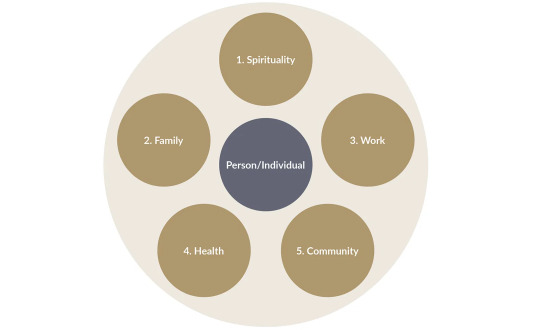
There are a great number of divisions and domains in life (Rojas, 2006; Cummins, 2003; Headey & Wearing, 1992; Veenhoven, 1996), encompassing anywhere from a small range to the infinite possibilities of human activities and areas of being (Rojas, 2006).
Vanderweele (2017) generally suggests that there are 5 domains of human life that should be focused on to promote human flourishing:
Spirituality. This area of life should be prioritized but is often neglected (Moberg & Brusek, 1978). Although the words religion and spirituality are often used interchangeably, a person does not have to practice a faith to be spiritual (Mercadante, 2014). Spirituality enables a purpose in life and dictates how someone may think, feel, and behave to allow them to gain fulfillment (Mercadante, 2014). Spirituality is based on an individual’s principles and focuses on creating a good life for themselves (Dierendonck, 2011). When a person’s actions are not in line with their spiritual beliefs, this can cause an imbalance within this life domain.
Family. An essential but influential domain. Family does not have to be biological. More importantly, it relates to people with whom you have a meaningful relationship (Robins & Tomanec, 1962). The family domain is an area of life that can become imbalanced when a person’s roles and responsibilities are not being fulfilled. This may be because another domain is receiving more attention, such as work (Rao & Indla, 2010). It may be that the beliefs, values, and behaviors of the person are not in line with other family members. When this domain is imbalanced, it results in fractured relationships, estrangement, and separations (Olah, Kotowska, & Richter, 2018).
Work. Plays a fundamental part in the life of most adults throughout all societies. It has an economic and instrumental role because it provides a livelihood (Scoones, 2009). Work provides a will to learn, develop, and accomplish goals. Work also has a psychosocial aspect. It gives meaning to an individual’s life and satisfies their need to be part of society (Sharabi & Harpaz, 2007). It is important that people enjoy what they are doing, where they are working, and who they are working with. If an individual is investing too much time in this domain to the detriment of other domains, it may cause an imbalance.
Health. This domain concerns physical, emotional, and mental health and wellbeing. Individuals can learn how to develop a healthy lifestyle from an early age through education (Cutler & Lleras-Muney, 2014). Physical health can deteriorate from work stress and financial demands. Poor health can affect independent living and the ability to work and engage with family members and the community. This can be detrimental to positive emotional and mental health and wellbeing (Wong, Chan, & Ngan, 2019). It is essential to adopt a healthy lifestyle and promote healthy living. Understanding how to exercise, eat healthily, relax, and connect spiritually helps to promote overall health.
Community. Relationships outside the family are essential (Darling, Hamilton, & Shaver, 2003). These can be with friends or specific communities, such as the neighborhood community, faith or sports-based interests, or hobbies that allow a person to develop a sense of belonging with others (Darling et al., 2003). Community allows people to be united and, like family, allows a sense of safety and security (Bowe et al., 2020). It provides a sense of achievement and fulfillment, especially when an individual is working toward a shared community goal, such as raising money for a good cause or helping others within the community (Bowe et al., 2020). Nevertheless, spending too much time with the community and neglecting other domains, such as family, can cause an imbalance.
This is a simple and easy-to-understand model that illustrates the main life domains recognized by most people. Vanderweele's interpretation is widely recognized and will help you understand how life domains interact with each other and how you can find balance between them.
The following are strategies or techniques that can be used to balance life domains.
Compensation is a technique that increases positive life domains to counteract negative life domains. Decreasing the not-so-good parts of negative life domains reduces the unhappy influence from these domains on overall life satisfaction (Lee & Sirgy, 2018).
Accept and acknowledge that not everything can be done in every domain all the time. There will always be limitations to getting everything done due to constraints on time, energy, and money. The ability to accept ourselves is a crucial factor in improving our overall feelings of emotional wellbeing (MacInnes, 2006).
Breitman and Hatch (2000) wrote a book on a straightforward idea to balance life domains. Their book concerns the art of saying ‘no’ without feeling guilty. The use of this two-letter word can help us rid ourselves of all the things that are preventing us from living positively in all domains.
Planning time and organizing activities that are the main priority can help to minimize stress. Poor organization and time management may cause life domains to feel stretched and overloaded.
Ensure time is scheduled for relaxation. Many studies have found this is important in reducing stress, anxiety, and low mood (Manzoni, Pagnini, Castelnuovo, & Molinari, 2008).
Flourishing - a condition denoting good mental and physical health: the state of being free from illness and distress but, more important, of being filled with vitality and functioning well in one’s personal and social life.
Languishing - the condition of absence of mental health, characterized by ennui, apathy, listlessness, and loss of interest in life.
Sources: 1 2 ⚜ More: Notes & References ⚜ Writing Resources PDFs
#writing reference#life domains#psychology#character development#writeblr#dark academia#literature#writers on tumblr#spilled ink#creative writing#character building#writing prompt#light academia#lit#writing inspiration#writing resources
87 notes
·
View notes
Text
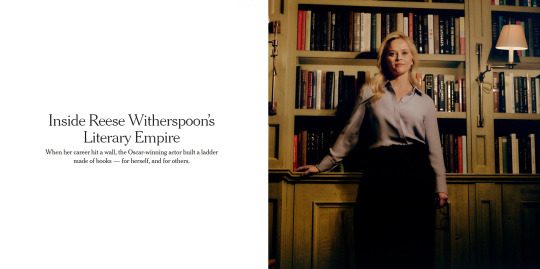
By Elisabeth Egan May 18, 2024
“You’d be shocked by how many books have women chained in basements,” Reese Witherspoon said. “I know it happens in the world. I don’t want to read a book about it.”
Nor does she want to read an academic treatise, or a 700-page novel about a tree.
Sitting in her office in Nashville, occasionally dipping into a box of takeout nachos, Witherspoon talked about what she does like to read — and what she looks for in a selection for Reese’s Book Club, which she referred to in a crisp third person.
“It needs to be optimistic,” Witherspoon said. “It needs to be shareable. Do you close this book and say, ‘I know exactly who I want to give it to?’”
But, first and foremost, she wants books by women, with women at the center of the action who save themselves. “Because that’s what women do,” she said. “No one’s coming to save us.”
Witherspoon, 48, has now been a presence in the book world for a decade. Her productions of novels like “Big Little Lies,” “Little Fires Everywhere” and “The Last Thing He Told Me” are foundations of the binge-watching canon. Her book club picks reliably land on the best-seller list for weeks, months or, in the case of “Where the Crawdads Sing,” years. In 2023, print sales for the club’s selections outpaced those of Oprah’s Book Club and Read With Jenna, according to Circana Bookscan, adding up to 2.3 million copies sold.
So how did an actor who dropped out of college (fine, Stanford) become one of the most influential people in an industry known for being intractable and slightly tweedy?
It started with Witherspoon’s frustration over the film industry’s skimpy representation of women onscreen — especially seasoned, strong, smart, brave, mysterious, complicated and, yes, dangerous women.
“When I was about 34, I stopped reading interesting scripts,” she said.
Witherspoon had already made a name for herself with “Election,” “Legally Blonde” and “Walk the Line.” But, by 2010, Hollywood was in flux: Streaming services were gaining traction. DVDs were following VHS tapes to the land of forgotten technology.
“When there’s a big economic shift in the media business, it’s not the superhero movies or independent films we lose out on,” Witherspoon said. “It’s the middle, which is usually where women live. The family drama. The romantic comedy. So I decided to fund a company to make those kinds of movies.”
In 2012, she started the production company Pacific Standard with Bruna Papandrea. Its first projects were film adaptations of books: “Gone Girl” and “Wild,” which both opened in theaters in 2014.
Growing up in Nashville, Witherspoon knew the value of a library card. She caught the bug early, she said, from her grandmother, Dorothea Draper Witherspoon, who taught first grade and devoured Danielle Steel novels in a “big cozy lounger” while sipping iced tea from a glass “with a little paper towel wrapped around it.”
This attention to detail is a smoke signal of sorts: Witherspoon is a person of words.
When she was in high school, Witherspoon stayed after class to badger her English teacher — Margaret Renkl, now a contributing opinion writer for The New York Times — about books that weren’t part of the curriculum. When Witherspoon first moved to Los Angeles, books helped prepare her for the “chaos” of filmmaking; “The Making of the African Queen” by Katharine Hepburn was a particular favorite.
So it made sense that, as soon as Witherspoon joined Instagram, she started sharing book recommendations. Authors were tickled and readers shopped accordingly. In 2017, Witherspoon made it official: Reese’s Book Club became a part of her new company, Hello Sunshine.
The timing was fortuitous, according to Pamela Dorman, senior vice president and publisher of Pamela Dorman Books/Viking, who edited the club’s inaugural pick, “Eleanor Oliphant is Completely Fine.” “The book world needed something to help boost sales in a new way,” she said.
Reese’s Book Club was that something: “Eleanor Oliphant” spent 85 weeks on the paperback best-seller list. The club’s second pick, “The Alice Network,” spent nearly four months on the weekly best-seller lists and two months on the audio list. Its third, “The Lying Game,” spent 18 weeks on the weekly lists.
“There’s nothing better than getting that phone call,” added Dorman, who has now edited two more Reese’s Book Club selections.
Kiley Reid’s debut novel, “Such a Fun Age,” got the nod in January 2020. She said, “When I was on book tour, a lot of women would tell me, ‘I haven’t read a book in four years, but I trust Reese.’” Four years later, on tour for her second novel, “Come and Get It,” Reid met women who were reading 100 books a year.
Witherspoon tapped into a sweet spot between literary and commercial fiction, with a few essay collections and memoirs sprinkled in. She turned out to be the literary equivalent of a fit model — a reliable bellwether for readers in search of intelligent, discussion-worthy fare, hold the Proust. She wanted to help narrow down the choices for busy readers, she said, “to bring the book club out of your grandma’s living room and online.”
She added: “The unexpected piece of it all was the economic impact on these authors’ lives.”
One writer became the first person in her family to own a home. “She texted me a picture of the key,” Witherspoon said. “I burst into tears.”
Witherspoon considers a handful of books each month. Submissions from publishers are culled by a small group that includes Sarah Harden, chief executive of Hello Sunshine; Gretchen Schreiber, manager of books (her original title was “bookworm”); and Jon Baker, whose team at Baker Literary Scouting scours the market for promising manuscripts.
Not only is Witherspoon focused on stories by women — “the Bechdel test writ large,” Baker said — but also, “Nothing makes her happier than getting something out in the world that you might not see otherwise.”
When transgender rights were in the headlines in 2018, the club chose “This Is How It Always Is,” Laurie Frankel’s novel about a family grappling with related issues in the petri dish of their own home. “We track the long tail of our book club picks and this one, without fail, continues to sell,” Baker said.
Witherspoon’s early readers look for a balance of voices, backgrounds and experiences. They also pay attention to the calendar. “Everyone knows December and May are the busiest months for women,” Harden said, referring to the mad rush of the holidays and the end of the school year. “You don’t want to read a literary doorstop then. What do you want to read on summer break? What do you want to read in January?”
Occasionally the group chooses a book that isn’t brand-new, as with the club’s April pick, “The Most Fun We Ever Had,” from 2019. When Claire Lombardo learned that her almost-five-year-old novel had been anointed, she thought there had been a mistake; after all, her new book, “Same As it Ever Was,” is coming out next month. “It’s wild,” Lombardo said. “It’s not something that I was expecting.”
Sales of “The Most Fun We Ever Had” increased by 10,000 percent after the announcement, according to Doubleday. Within the first two weeks, 27,000 copies were sold. The book has been optioned by Hello Sunshine.
Witherspoon preferred not to elaborate on a few subjects: competition with other top-shelf book clubs (“We try not to pick the same books”); the lone author who declined to be part of hers (“I have a lot of respect for her clarity”); and the 2025 book she’s already called dibs on (“You can’t imagine that Edith Wharton or Graham Greene didn’t write it”).
But she was eager to set the record straight on two fronts. Her team doesn’t get the rights to every book — “It’s just how the cookie crumbles,” she said — and, Reese’s Book Club doesn’t make money off sales of its picks. Earnings come from brand collaborations and affiliate revenue.
This is true of all celebrity book clubs. An endorsement from one of them is a free shot of publicity, but one might argue that Reese’s Book Club does a bit more for its books and authors than most. Not only does it promote each book from hardcover to paperback, it supports authors in subsequent phases of their careers.
Take Reid, for instance. More than three years after Reese’s Book Club picked her first novel, it hosted a cover reveal for “Come and Get It,” which came out in January. This isn’t the same as a yellow seal on the cover, but it’s still a spotlight with the potential to be seen by the club’s 2.9 million Instagram followers.
“I definitely felt like I was joining a very large community,” Reid said.
“Alum” writers tend to stay connected with one another via social media, swapping woot woots and advice. They’re also invited to participate in Hello Sunshine events and Lit Up, a mentorship program for underrepresented writers. Participants get editing and coaching from Reese’s Book Club authors, plus a marketing commitment from the club when their manuscripts are submitted to agents and editors.
“I describe publishing and where we sit in terms of being on a river,” Schreiber said. “We’re downstream; we’re looking at what they’re picking. Lit Up gave us the ability to look upstream and say, ‘We’d like to make a change here.’”
The first Lit Up-incubated novel, “Time and Time Again” by Chatham Greenfield, is coming out from Bloomsbury YA in July. Five more fellows have announced the sales of their books.
As Reese’s Book Club approaches a milestone — the 100th pick, to be announced in September — it continues to adapt to changes in the market. Print sales for club selections peaked at five million in 2020, and they’ve softened since then, according to Circana Bookscan. In 2021, Candle Media, a Blackstone-backed media company, bought Hello Sunshine for $900 million. Witherspoon is a member of Candle Media’s board. She is currently co-producing a “Legally Blonde” prequel series for Amazon Prime Video.
This month, Reese’s Book Club will unveil an exclusive audio partnership with Apple, allowing readers to find all the picks in one place on the Apple Books app. “I want people to stop saying, ‘I didn’t really read it, I just listened,’” Witherspoon said. “Stop that. If you listened, you read it. There’s no right way to absorb a book.”
She feels that Hollywood has changed over the years: “Consumers are more discerning about wanting to hear stories that are generated by a woman.”
Even as she’s looking forward, Witherspoon remembers her grandmother, the one who set her on this path.
“Somebody came up to me at the gym the other day and he said” — here she put on a gentle Southern drawl — “‘I’m going to tell you something I bet you didn’t hear today.’ And he goes, ‘Your grandma taught me how to read.’”
Another smoke signal, and a reminder of what lives on.
#reese witherspoon#reese's book club#reading#literary#club#book#new york times#elisabeth egan#article
197 notes
·
View notes
Text
My obsession with Yennefer (long post!)
Yennefer was ALWAYS my favourite character from an entire Witcher franchise and easily my favourite character from any fictional story. I drew her, sketched her, wrote about her obsessively since I first read the Witcher in 2013.
Let's give it a try and gather all of the Yennefer pieces and sketches I ever did, because I had a Witcher brainrot for many, many years. Spoler alert: all of my Yens are totally different!
This one from 2014 was probably inspired by the The Bounds of Reason.

The one that was inspired by the very first Yennefer render from CDProjektRed.

The weird one. I don't really like her.

2015! The Shard of Ice Yennefer:

Don't have much to say about this one either, I guess it was an experiment.

The one I don't remember drawing. Somehow I predicted the Netflix!Yen having these exact eyeshadows.

Oh I love this one! This is a mix of game!Yen and book!Yen:

The next one is pure game!Yennefer, even though I never liked her in-game design (especially the bangs, the small nose and the lips):

Basically, this is how I saw it: game!Yen meeting the book!Yen.
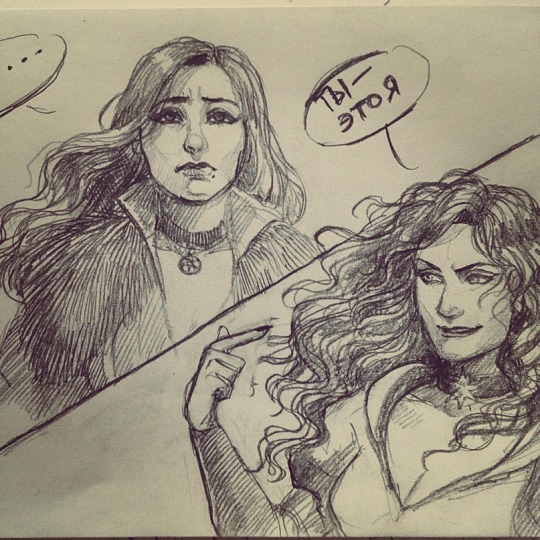
Late 2015/early 2016 traditional sketches (yes, the second one is Yen from the Hexer):


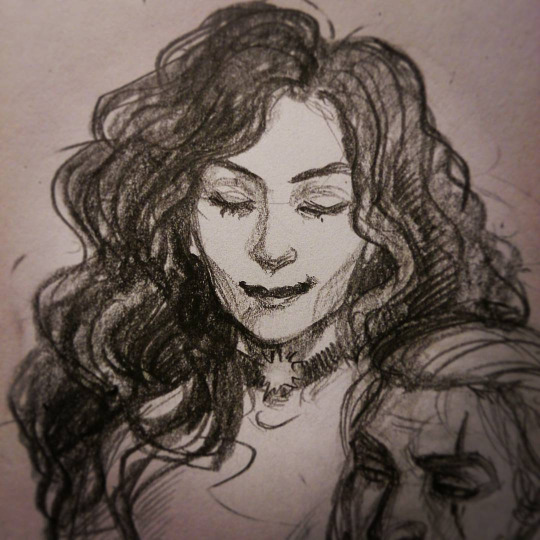
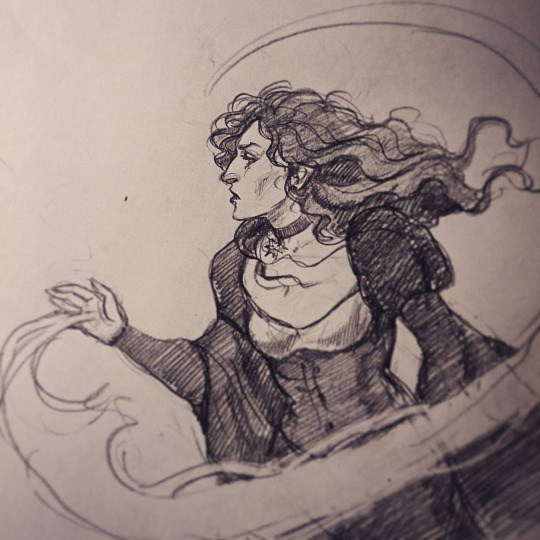

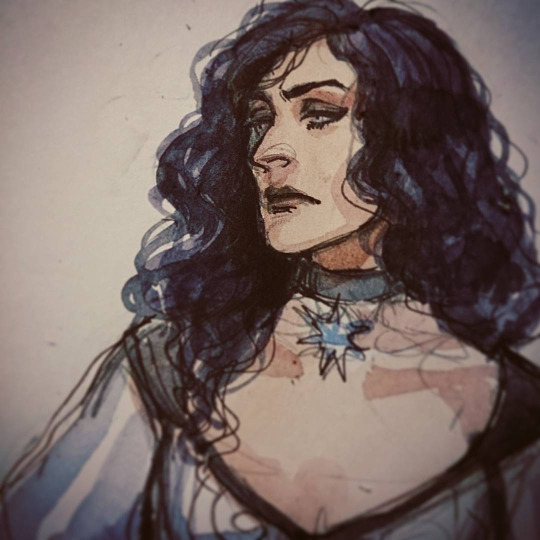
THE FAVOURITE ONE. I haven't watched Farscape until 2018 and when I first saw Claudia Black I GASPED, because to me she looked exactly like this Yen version I drew back in 2016 and still is madly in love with.
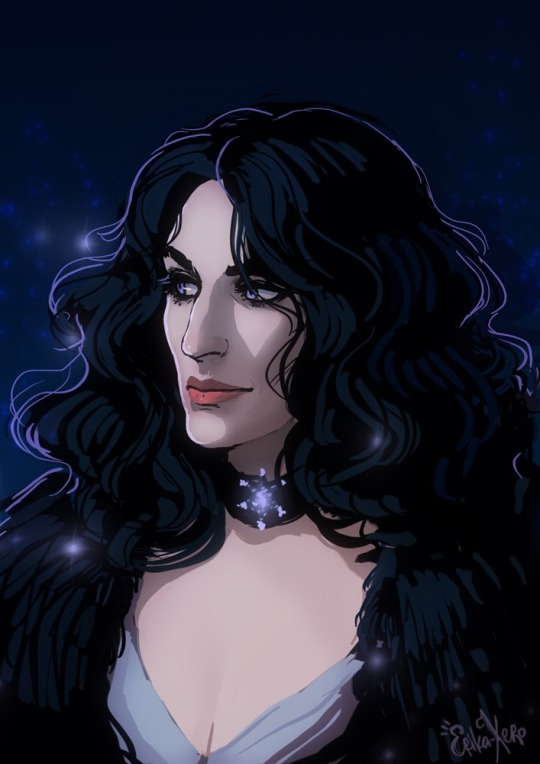
Apparently there was an infinished second piece of this exact Yen design but I never posted the high resolution of it which is kinda sad.
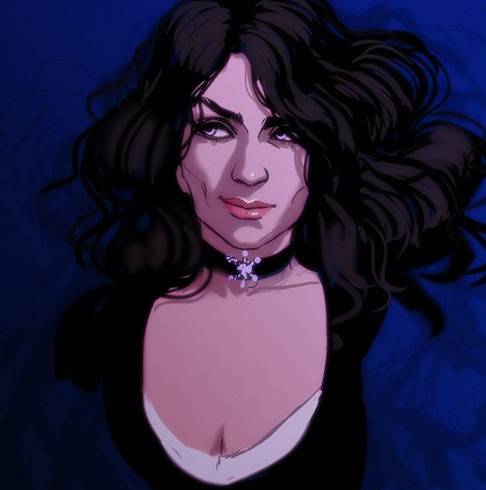
2017! I saw early game!Yen designs and did a sketchy portrait of her. And then I decided to make the second version with the book!Yen:


Finally, Yennefer from 2022 (original sketch and the colored sketch). This design seems the most book accurate to me, but I still love all the previous ones I did (except the weird one, she is creepy).
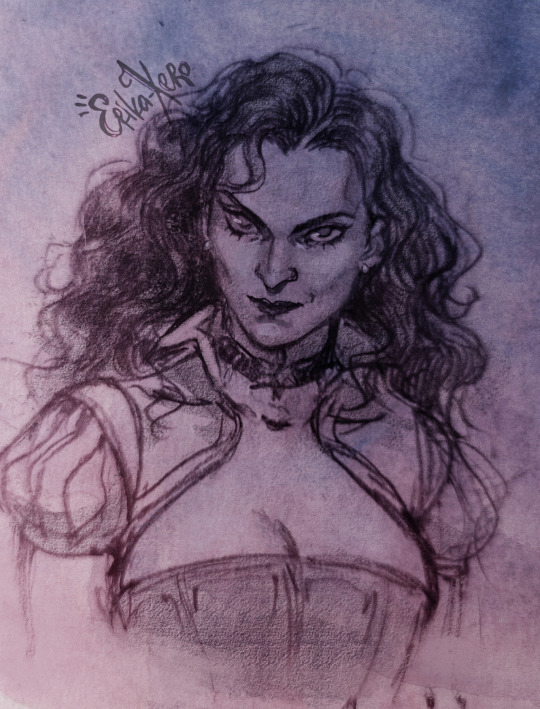
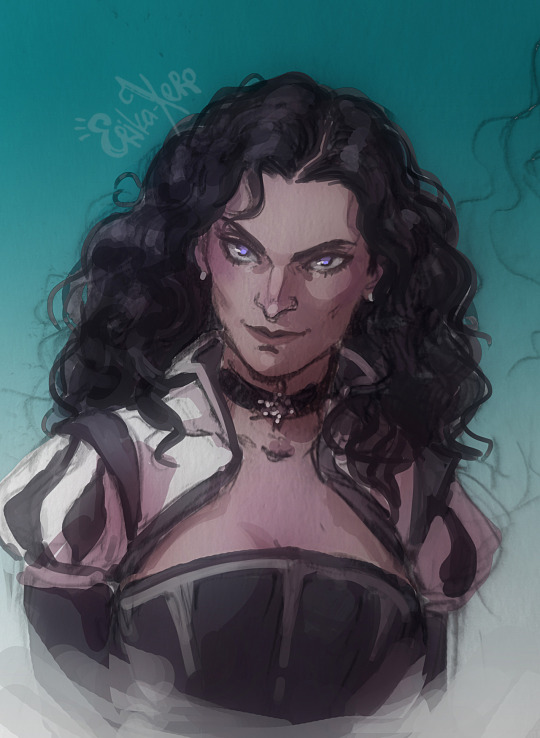
And the last, but not the least: my own Thanedd ball outfit for Netflix!Yen, portrayed by Anya Chalotra.

And a small bonus! The very first Yennefer sketch I ever did (2013!)

#fantasy#yennefer#the witcher#yennefer z vengerbergu#yennefer the witcher#netflix yennefer#game!yennefer#book!yennefer#traditional art#digital art#art progress#sketch#favourite character#i was fucking obsessed with this woman#I wanted to be her#witcher brainrot
589 notes
·
View notes
Text
𝓭𝓪𝓻𝓴 𝓪𝓬𝓪𝓭𝓮𝓶𝓲𝓪 ˙⟡🪶─
𝒎𝒐𝒗𝒊𝒆 𝒂𝒏𝒅 𝒕𝒗 𝒔𝒉𝒐𝒘 𝒓𝒆𝒄𝒐𝒎𝒎𝒆𝒏𝒅𝒂𝒕𝒊𝒐𝒏𝒔
Some of my favourite movies and tv shows that I keep rewatching literally all the time, also fit the dark academia aesthetic...
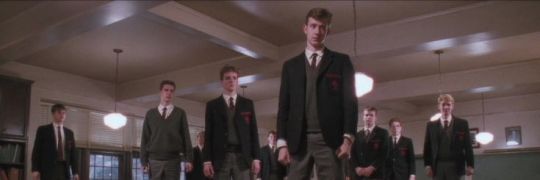
𝒎𝒐𝒗𝒊𝒆𝒔
Dead Poets Society (1989)
A timeless film about the power of literature and the consequences of challenging societal norms in a boarding school.
The Talented Mr. Ripley (1999)
A psychological thriller drenched in luxury, deception, and the pursuit of identity.
Kill Your Darlings (2013)
Follows young Allen Ginsberg and his entanglement in a murder during his time at Columbia University.
Atonement (2007)
A visually stunning film about love, betrayal, and regret, with an air of intellectual melancholy.
The Imitation Game (2014)
A story of genius and tragedy, focusing on Alan Turing’s work during WWII.
The Riot Club (2014)
A dark examination of privilege and elitism among Oxford students in a secret society.
Harry Potter Series (2001-2011)
Especially The Prisoner of Azkaban, which captures the darker, atmospheric tones of the series.
Crimson Peak (2015)
A Gothic romance with haunting visuals and themes of mystery and intellect.
The Oxford Murders (2008)
A mystery set at Oxford University, blending logic, philosophy, and crime-solving.
The Theory of EVerything (2014)
A poignant biopic about Stephen Hawking’s life, featuring beautiful academic settings.

𝒕𝒗 𝒔𝒆𝒓𝒊𝒆𝒔
The Umbrella Academy (2019-2024)
While more fantastical, its themes of family, ambition, and intellectualism align with dark academia. (we're going to act as if the 4th season never happened)
Sherlock (2010-2017)
A modern take on Arthur Conan Doyle’s detective stories, with a focus on intellect and mystery.
The Queen’s Gambit (2020)
A visually stunning series about genius, competition, and the pressures of academia-like environments.
Penny Dreadful (2014-2016)
A Gothic series weaving together classic literary characters with dark, intellectual themes.
How to Get Away with Murder (2014-2020)
A thrilling blend of academia and crime, revolving around law students entangled in murder mysteries.
Derry Girls (2018-2022)
Though comedic, the show captures an academic setting with themes of friendship and youthful rebellion.
The Magicians (2015-2020)
A fantasy series with a dark academia feel, featuring a secret university for magic and complex moral questions.
His Dark Materials (2019-2022)
A richly intellectual fantasy series set in an alternate, academic-focused world.
Gilmore Girls (2000-2007)
While lighter, it captures the love of books, academia, and witty intellectual banter.
Shadow and Bone (2021-)
A mix of dark fantasy and the kind of rich world-building that appeals to dark academia enthusiasts.

Let me know your favourite movies and/or tv shows that I should watch.
-michala♡
#dark academia#dark academia aesthetic#dark academia vibes#dark academia moodboard#dark academia movies#movie recommendations#must watch#movies and tv shows#dark academia tv shows#books and libraries#bbc sherlock#dead poets society#shadow and bone#kill your darlings#tv show recommendations
123 notes
·
View notes
Text
a cursed realization: wade and logan are old men. logan especially so.
they MUST have weird old man habits and general body weirdness. and not the endearing shit like preferring to use old school tech, or having a "get off my lawn, my favourite miscreants" kinda attitude, or being unable to keep up in sex, or any of that kinda cute stuff
i mean the unpleasant sweaty old man smell, having walking farts, snoring while awake, their stomachs just making noises for no goddamn reason bc their digestive systems are no longer 30 y/o
all of which they don't even realize they're doing bc they're old and either a) have more pressing things to worry about [at their age]; b) stopped giving a fuck; or c) both of the above
source: i live with two very old men (my dad and uncle). one is a few years away from retirement and the other is already at that age. they are family but they are still gross old men who act like drunk uncles given half the chance
and while neither logan or wade are in their 60s, these habits don't just magically appear once you hit that age. they begin long before that and accumulate over time until the stinky old man package is complete
"but jercy," you say, "they have perfect regeneration!! they can't have any health problems!! they're too self-conscious to be that gross!!"
1: (re: perfect regeneration) that is an even worse argument for wade, who has mega cancer and canonically does not smell pleasant or have a properly functioning body. he'd 100% have old man problems as a symptom of his cancer bc his mutation is physically keeping him in a constant state of dying. everything he does is out of sheer stubbornness and willpower to make a joke out of his life
1b: to play on a popular headcanon: any aromatic, artificial fruity skincare routine he has can easily be used as a reason for him to cover up his old man smell
2: see point B above for logan
2b: see the movie, logan (2017), or the comic, death of wolverine (2014), for the fact that logan can canonically age/die. albeit it's at a vastly slower pace than everyone else, but it means logan WILL eventually have these issues with his body too, if he doesn't have them already
2c: feral/animalistic logan who takes on animal traits would be so much worse bc wolverines are called "skunk bears" for a reason. wolverines (and any wildlife/animal that you can compare logan to) fucking STINK!! they have EVEN GROSSER ANIMAL HABITS!! you just gotta accept it
3: (re: self-consciousness) you got a point there, but once again refer to point B. most folks i know at their age are on their way to or have already stopped caring about what others think of them. and even if wade and logan are somehow the exceptions to this, i'm sure they let loose in private and probably indulge in their grosser habits when they're alone
4: if you want biblically accurate old man yaoi you're gonna have to contend with the fact that it comes with the non-sexy old man problems. i'm sorry i have to break the illusion but this is the reality we must face together
5: suspension of disbelief, friends. do engage with that once in a while lol
in conclusion: i unfortunately have every bit of confidence that wade and logan are not exempt from old man behaviours and bodily functions and i will die whining about it. thanks for coming to my ted talk
#deadpool and wolverine#deadpool & wolverine#dp&w#poolverine#wolverpool#deadclaws#peanutbub#deadpool#wade wilson#wolverine#logan howlett#wade wilson x reader#deadpool x reader#logan howlett x reader#wolverine x reader#jercy speaks#meta#.happy 51st birthday 10005 wade wilson!!! i'm exposing yours and logan's old man tendencies!!!#.anyway rip my poolverine week entries y'all just gonna hafta wait kjlfdskljdsflkjdfs#.i have been thinking about this SO much ngl#.sexy old man yaoi must come with un-sexy old man problems 😔😔😔
76 notes
·
View notes
Text
#ITPE 2024 MASTERLIST!
(This has also been crossposted to the Amplificathon DW community)
(If you'd like to see previous years' master lists, 2011 is here, 2012 is here, 2013 is here, 2014 is here, 2015 is here, 2016 is here, 2017 is here, 2018 is here, 2019 is here, 2020 is here, 2021 is here, 2022 is here, and 2023 is here.)
Happy 14th annual #ITPE/technically 1st Informal Tumblr Podfic Exchange!!!! Thank you for bearing with us in our switch to a new platform! We’ve had a few hiccups but now that we know where those are, future years will hopefully run much more smoothly!
Here’s some stats and highlights from this year’s #ITPE!
We had 81 participants this year, and you made 313 podfics (including some ~sekrit~ gifts not available on the masterlist) for a total run time of 140 hours, 59 minutes, and 4 seconds–that’s over FIVE DAYS of audio!
We have 4 simulpods this year! Which is less than we expected, given some of the niche fandoms and crossovers we matched y’all on, so congratulations on finding a diversity of fics to record! @sunshineprincejeremyknox | @flowerparrish and @jeremyknox | @kbirbpods were responsible for two of those simulpods, one which they gifted to each other and the other which they both gifted to the same person. @eafay70 and @tinybluebirdcloak both gifted the same fic to @read-by-silverandblue. Finally, @alliaskisthepossibilityoflove and @rhea314 both recorded the same fic for different participants!
While #ITPE encourages participants to embrace the no-minimums, low-stress vibe, some of y’all do like to Do the Most, and we like to recognize extraordinary effort when we see it!
@opalsong, usually a notorious podfic robot, has had a lot going on this year in terms of school and was worried she would not be able to hit the productivity highs of previous years. So we, as mods, thought, “Great! We know what to do! We’ll match her with someone on one very specific OT3 that this recipient has been requesting for years, in a fandom not especially known for blanket permission, and that way Opal won’t feel compelled to make a bajillion podfics because the pool will be so small! We are solving so many problems with this match!” And we thought we were so clever! Only for Opalsong to find a 90k fanfic and turn in a 12 hour podfic. Well. We tried! But clearly Opalsong is going to Opalsong. <3
By far our most prolific gifter this year was @sunshineprincejeremyknox | @flowerparrish, who not only made 6 gifts for zir recipient (including a 4 hour podfic), but also 31 treats. Not far behind was @mistbornhero who made 7 main gifts and 23 treats! @jeremyknox | @kbirbpods made 4 main gifts and 18 treats! We also had generous treaters in @wanderingjedihistorian, @reena-jenkins, @blackestglass, @pezzax, and @wilfriede! Plus, honorable mentions to @daisydiversions and @annabelle-myrtille for the 10 and 6 hour (respectively) podfics they made for their recipients!
Finally, we'd like to extend some thank you’s to:
-Data mod flowersforgraves for converting all the sign up data to airtable which makes matching so much easier. -Asymptotical and Dragonflies_and_Katydids for creating the coding we used to generate distribution day templates. -Everyone who offered to pinch hit, especially sunshineprincejeremyknox | flowerparrish and @jetainia, though thankfully we did not end up needing them to fulfill those pinch hits! -And as always, @exmanhater for ITPE’s permanent hosting
Now let’s get on to what you’re really here for…..the masterlist!! Here’s the masterlist spreadsheet for this year’s exchange!
Happy listening!!!
57 notes
·
View notes